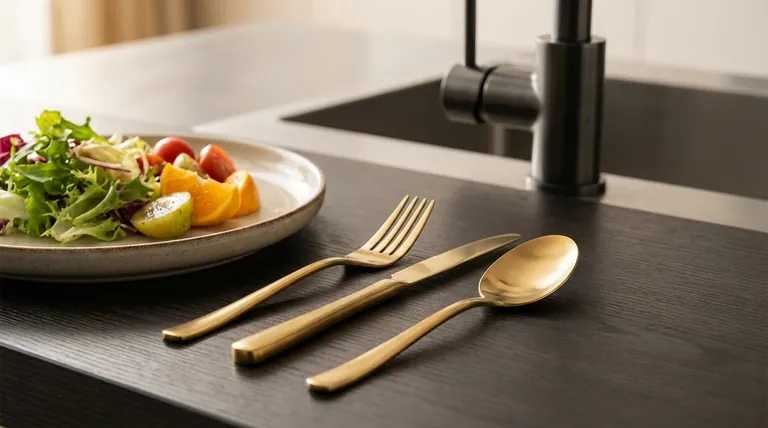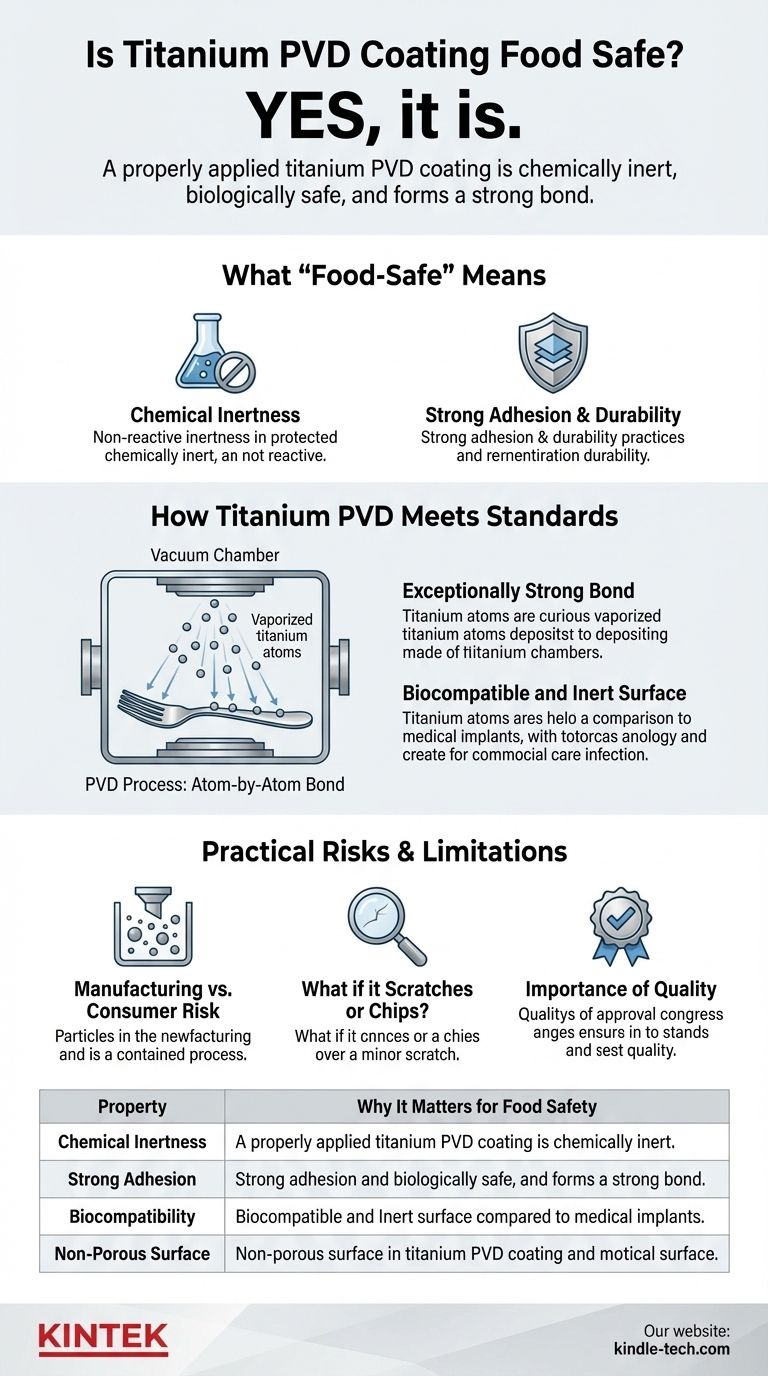In short, yes. A properly applied titanium PVD coating is considered food-safe for consumer products like cutlery and kitchen fixtures. This is because the coating is chemically inert, biologically safe, and forms an incredibly strong bond with the underlying material, preventing it from leaching or flaking into your food.
The safety of titanium PVD coatings is not just about the material itself, but about the process. PVD creates a durable, non-reactive, and strongly bonded surface that effectively seals the product, making it safe for food contact.

What "Food-Safe" Actually Means
To understand why PVD coatings are safe, we must first define the criteria for any food-safe material. It generally comes down to two key properties.
Chemical Inertness
A food-safe material must not react with the food it touches. It cannot corrode, dissolve, or release any molecules when exposed to common food acids (like lemon juice or vinegar) or alkaline substances.
Strong Adhesion & Durability
The material or coating cannot easily chip, flake, or wear off into food during normal use. Any surface that degrades easily poses a risk of being ingested.
How Titanium PVD Meets These Standards
Physical Vapor Deposition (PVD) is a high-tech vacuum coating process. It is fundamentally different from plating or painting, resulting in a finish that is molecularly bonded to the original item.
An Exceptionally Strong Bond
In the PVD process, solid titanium is vaporized in a vacuum chamber and then deposited atom-by-atom onto the substrate (such as stainless steel cutlery). This creates a finish that is not just on the surface, but fused to it.
This process is why PVD is trusted for commercial kitchen equipment and high-end cutlery that must withstand constant use and washing without degrading.
A Biocompatible and Inert Surface
Titanium itself is famously biocompatible—it's the same material used for medical and dental implants because the human body does not react to it.
The resulting PVD coating is a hard, ceramic-like layer (often titanium nitride) that is non-porous and chemically inert. It will not react with or alter the taste of your food.
Understanding the Practical Risks & Limitations
True objectivity requires looking at potential downsides. While titanium PVD is overwhelmingly safe for the end-user, it's important to understand the context.
Manufacturing vs. Consumer Risk
The reference to health risks from inhaling particles is relevant only to the manufacturing process. Once the coating is applied and bonded, the particles are locked in place and do not become airborne. This is not a risk for the consumer.
What if it Scratches or Chips?
While incredibly durable, no coating is indestructible. Under extreme abuse, it is theoretically possible to scratch or chip a PVD finish.
However, if a microscopic piece were to come off, it is an inert particle that would pass through the digestive system harmlessly. Furthermore, the underlying material is almost always stainless steel, which is also completely food-safe.
The Importance of Quality
The integrity of the coating depends on a quality application. Poorly executed PVD from a disreputable source could potentially have adhesion issues, though this is rare. Sticking to established brands ensures the process was done to high industrial standards.
Making the Right Choice for Your Product
When considering a product with a titanium PVD finish, your decision should be based on its intended use.
- If your primary focus is durable and decorative cutlery: A titanium PVD coating is an excellent, safe, and reliable choice that significantly increases scratch resistance.
- If your primary focus is kitchen fixtures (faucets, sinks): The coating provides a highly durable, corrosion-resistant, and easy-to-clean surface that is perfectly safe.
- If you are choosing non-stick cookware: Be aware that titanium PVD is for durability, not for creating a non-stick surface like PTFE (Teflon). It enhances wear resistance but doesn't provide the same food release.
By understanding the process behind the finish, you can confidently choose titanium PVD products for their safety and exceptional durability.
Summary Table:
| Property | Why It Matters for Food Safety |
|---|---|
| Chemical Inertness | Does not react with food acids or alkalis, preventing contamination. |
| Strong Adhesion | Atomically bonded finish resists chipping and flaking during use. |
| Biocompatibility | Made from titanium, a material safe for medical implants. |
| Non-Porous Surface | Creates a hygienic barrier that is easy to clean and prevents bacterial growth. |
Enhance your laboratory or kitchen products with safe, durable coatings from KINTEK!
As a leading supplier of high-quality lab equipment and consumables, KINTEK specializes in solutions that meet the highest safety and performance standards. Whether you are developing new cutlery, kitchen fixtures, or other products requiring a food-safe finish, our expertise can help you achieve superior results.
Contact us today to discuss how our solutions can benefit your next project!
Visual Guide

Related Products
- Vacuum Hot Press Furnace Machine for Lamination and Heating
- Split Chamber CVD Tube Furnace with Vacuum Station Chemical Vapor Deposition System Equipment Machine
- Vacuum Heat Treat Furnace with Ceramic Fiber Liner
- Small Vacuum Heat Treat and Tungsten Wire Sintering Furnace
- 1200℃ Controlled Atmosphere Furnace Nitrogen Inert Atmosphere Furnace
People Also Ask
- What is the advantage by using hot press forming? Achieve Stronger, More Complex Parts
- What are the advantages and disadvantages of hot stamping? Unlock Ultra-High Strength for Automotive Parts
- What is vacuum lamination? Achieve a Flawless, Durable Finish on Complex Shapes
- What is hot press forging? Creating Complex, High-Strength Metal Components
- What is the purpose of laminating? Protect and Enhance Your Documents for Long-Term Use



















